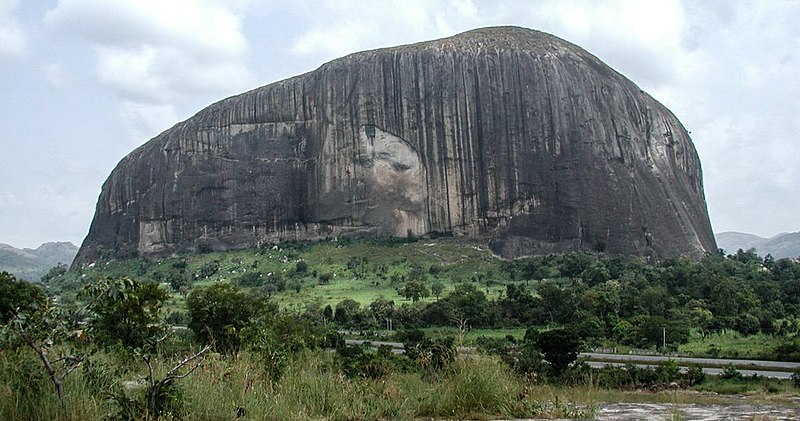Zuma Rock is a large monolith located in Nigeria, specifically in Niger State. It’s often referred to as the “Gateway to Abuja”
because it’s visible from the capital city, Abuja, and serves as a distinctive landmark. Zuma Rock holds cultural significance
to the people of Nigeria and is a popular tourist attraction.
Majestically in the heart of Nigeria’s Niger State, Zuma Rock stands as an enduring symbol of the nation’s rich cultural heritage
and natural beauty. Towering over the surrounding landscape, this awe-inspiring monolith has captured the imagination of
visitors and locals alike for generations, earning its place as one of West Africa’s most iconic landmarks.
Check out an amazing video here: https://www.youtube.com/watch?v=jHrJgpDFULQ
A Geological Wonder
Delve deeper into the geological processes that contributed to the formation of Zuma Rock, discussing its composition, age,
and the forces of erosion and weathering that sculpted its distinctive features over time.
Formed over millions of years through geological processes, Zuma Rock rises abruptly from the undulating plains, reaching
a height of approximately 725 meters (2,379 feet). Its striking appearance, characterized by sheer vertical cliffs and rugged contours,
is a testament to the forces of nature that shaped it.
Cultural Significance
Zuma Rock holds profound cultural significance for the indigenous people of Nigeria, particularly the Gbagyi ethnic group who
inhabit the surrounding area. Revered as a sacred site, it is steeped in myths, legends, and folklore, serving as a focal point for spiritual rituals and traditional ceremonies.
Examine the influence of Zuma Rock on art, literature, and popular culture, both within Nigeria and globally. Explore
how artists, writers, and filmmakers have drawn inspiration from its majestic presence and symbolic significance.
According to local legend, Zuma Rock was once a refuge for the people of the area during times of conflict, providing shelter
and protection from adversaries. Today, it continues to be regarded with deep reverence and respect, reflecting the enduring
connection between the land and its people.
Discuss the economic significance of Zuma Rock, including its contributions to tourism, local livelihoods, and economic
development in the surrounding communities. Highlight initiatives aimed at harnessing its tourism potential while promoting sustainable economic growth.
Gateway to Abuja
Situated just 40 kilometers (25 miles) from Nigeria’s bustling capital city, Abuja, Zuma Rock holds the distinction of being affectionately referred to as the “Gateway to Abuja.” Its prominent presence on the horizon serves as a welcoming beacon for travelers arriving in the city, offering a sense of familiarity and orientation.
Beyond its cultural and geographical significance, it has also emerged as a popular tourist destination, drawing visitors from far and wide to marvel at its natural splendor. Guided tours are available for those eager to explore the rock’s rugged terrain and learn about its geological features and cultural heritage.
Examine the influence of Zuma Rock on art, literature, and popular culture, both within Nigeria and globally. Explore how artists, writers, and filmmakers have drawn inspiration from its majestic presence and symbolic significance.
Additionally, the surrounding area offers ample opportunities for outdoor enthusiasts, with hiking trails, picnic spots, and breathtaking viewpoints providing unforgettable experiences for nature lovers and adventure seekers alike.
Conservation Efforts
Recognizing the importance of preserving this natural treasure for future generations, efforts have been made to safeguard and its surrounding ecosystem. Conservation initiatives aim to mitigate the impact of human activity, promote sustainable tourism practices, and raise awareness about the importance of environmental stewardship.
Address the conservation challenges facing Zuma Rock and its surrounding environment, such as habitat degradation, deforestation, and unsustainable tourism practices. Discuss the importance of ongoing conservation efforts and community involvement in protecting this natural heritage site.
Consider the future prospects of Zuma Rock as a cultural, geological, and ecological landmark. Discuss potential strategies for ensuring its long-term preservation and sustainable management for the benefit of future generations.
In conclusion, Zuma Rock stands as a testament to the enduring power of nature and the rich cultural heritage of Nigeria. Its majestic presence continues to inspire wonder and reverence, drawing visitors from across the globe to witness its splendor firsthand. As a symbol of resilience, beauty, and cultural identity, Zuma Rock holds a special place in the hearts of all who encounter it, embodying the spirit of Nigeria’s past, present, and future.
Read Also: https://placesandlifestyle.com/exploring-gberefu-island/




